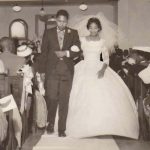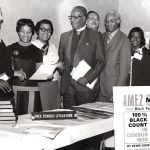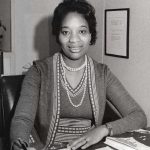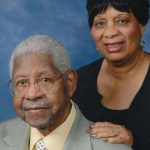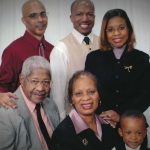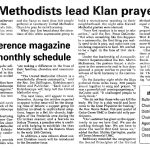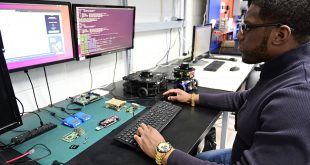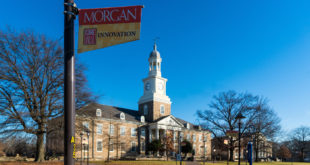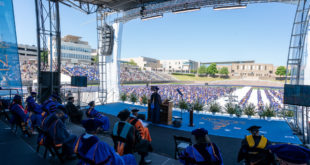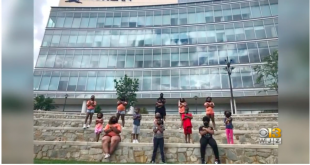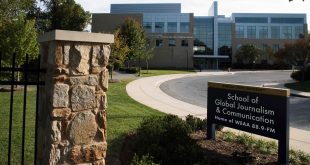“…We put out some of the first data from the Census Bureau that was on the black population, and some of the first reports (on those data). And I got a number of awards for that.”
— Nampeo McKenney
“I remember one Sunday, (Dr. King) looked at us, and he smiled, and he said, ‘I hope my sermon met you all’s approval.’…But that was the kind of person he was.”
— Martin McKenney
Martin and Nampeo McKenney met at Morgan, where they were part of a small group of sociology students who gathered in the library for studies after class. The friendship between the former Air Force airman and the aspiring demographer blossomed into love, and on Aug. 5, 1961, two years after their graduation, the two Charles County, Md., natives married. Martin and Nampeo had been active in the civil rights movement while they were at Morgan, and as graduates, they took that activism to places such as Westminster, Md., where Martin was pastor of a United Methodist Church, and the 1963 March on Washington, a city with which Nampeo was very familiar. It was there that she did groundbreaking work at the Census Bureau on data about minority groups. The McKenneys both continued their education after leaving Morgan. Nampeo earned a master’s degree in sociology from American University, and Martin is a graduate of Wesley Theological Seminary. Retired now and living in Bowie, Md., they are sometimes asked to speak publicly about their work for civil rights. The McKenneys have two children, Gilesa and Daniel; a grandchild, Michael-Luther; and a son-in-law, Vincent.
Interview Excerpts
May 22, 2014
EA: Tell me how you met.
Nampeo: We met at Morgan. As Marty said before, we used to go to the library after classes with some other friends, and we’d talk, and we became friends.
EA: Was that in your freshman year?
Nampeo: No, I think we started in about our junior year. We both were in the sociology department.
Martin: Before I got married, I went to the seminary in Atlanta. I went to Gammon (Theological Seminary), which is a big Methodist school down there. And then I transferred from Atlanta to Washington (D.C.). I went to Wesley Theological Seminary, which is the school I graduated from. My first appointment was in Westminster, Md. And, of course, I got married that year. And the difficulty with that was we lived in Washington and Westminster. I was going to school, and she was going to school. And weekends, we would be up in Westminster where I pastored. And I did that for two years. Then I moved down to Baltimore. I lived with my mother. She had a house down in Baltimore. So we lived there for two years. Then, after that, I moved to Glen Burnie, and I was there for four years.
Nampeo: That’s where our first child was born. Gilesa… We have two children, Gilesa and Daniel. And the oldest Gilesa lives in North Carolina, and Daniel…is in the Washington, D.C., area.
EA: So you were a full-time pastor, Mr. McKenney?
Martin: Yes. When I graduated from seminary, they appointed me to Westminster, and that was my first appointment.
EA: What denomination?
Martin: United Methodist.
EA: And did you retire as a pastor?
Martin: Yes (but after serving in several other appointments in the Baltimore and Washington areas).
EA: After how many years?
Martin: Oh, I retired in ’97, 1997.
EA: And Mrs. McKenney, you told me about your career. Can you recap that?
Nampeo: Yes. I went to work at the Census Bureau…really as a summer student and had planned to leave there and go to school full time. And they asked me to stay on, so I stayed on and went to American University part time…. I started out as a statistician…and I had a number of different types of experiences and jobs there at the Census Bureau. While I was there…I began to work on data (about) the black population. And we put out some of the first data from the Census Bureau that was on the black population, and some of the first reports (on those data). And I got a number of awards for that. Then it was expanded, and…(I) ended up working on data for other groups such as Hispanics, American Indians, Asian and Pacific Islanders. Then I began to work on issues related to the homeless, the elderly and other ethnic groups such as Irish and Arab Americans and so forth. So I really ended up working with a number of issues concerning different groups in the country and got a number of awards and recognitions for that.
EA: What years did you work at the Census Bureau?
Nampeo: I started in ’59, and I worked there through 2000. I was there about 42 years (laugh).
EA: And you retired in 2000?
Nampeo: Yes…. And during that time, I got a chance to meet with many…well-known leaders around the country and to talk with them about issues….
EA: It sounds like you were the “go to” person for policy makers needing statistics on minority groups. Is that true?
Nampeo: In the beginning, yes, because there was a very limited amount of data…. I also worked extensively with some of the researchers with the Urban League on the State of Black America (report) when that was in its early stages…. We worked closely with Dr. Robert Hill and Dorothy Newman and those who were the originators of that. And we worked with persons from Ebony magazine…. Lerone Bennett and some of the others who were doing their research would call and ask for assistance with their work. We also worked with a number of persons with the (U.S. presidential) administrations when issues would come up around the world….
Martin: One of the things that I forgot to mention to you was (that during) our first year in Western Maryland, CORE came to our church, and we began to demonstrate. This was when the racial issue was a hot issue in Maryland. And we used the church. And I never gave thought to the fact that the whites in Western Maryland, Westminster (some of whom were opposed to the civil rights movement), didn’t show their resentment of my little black church. They could have burned it down. They could have done several things. But they didn’t. And as a result, we made some gains in the (civil rights) theater there and got the people to realize that we are here to stay. We are Americans as well as anyone else. So it worked out pretty well.
Nampeo: …When we were at Morgan, we were involved with the student demonstrations at the lunch counters there and trying to integrate the theaters and the lunchrooms and everything. And so we were very actively involved in that. We used that (experience). When we left Morgan, we continued to be involved in the civil rights struggle.
(Morgan) also helped me in my career (at the Census Bureau). In fact, some of the professors at Morgan were really, really outstanding in helping us…get prepared for the outside world…. When I was in sociology, I wasn’t quite sure where I was going. (I) almost had a second major in math. I loved math, and it was one of my professors at Morgan (who) suggested (that I) go into demography or population studies as a field. And you know, he also told me at that time that there were very few blacks in that area (laugh). And he encouraged me, and there were several professors that were strong in encouraging me. And after I went to the Census Bureau, there were several professors that I continued to have a relationship with and (who) helped us with the work…at the Census Bureau…. I (would bring) some of (my) colleagues over to Morgan, and we’d sit down and discuss some of the issues….
EA: Do you remember the name of the professor who suggested you become a demographer?
Nampeo: Dr. Earl Moses, and then (Dr.) Clifton Jones was another strong person that I maintained contact with for a long time.
EA: Were they both math professors?
Nampeo: No, they were sociology. And the math professor was Dr. Proctor. Both Clifton Jones and Earl Moses had written articles and books….
Martin: One of the things that we didn’t realize the significance (of) at the time it occurred (was Dr. King’s) speech in Washington.
EA: The March on Washington?
Nampeo: Yes, uh huh.
Martin: And we were pleased that it turned out…. Several churches have asked us to give some little excerpts of how it was back in those days and so forth. It was interesting.
Nampeo: Yes, we’ve done that, and especially now because it’s been so long…the young people will say, ‘What was it like then?…How did you feel? What was going on?’ and to just sort of understand the whole climate and everything. And so we’ve done presentations on that. But again, that was part of our work with the civil rights.
I think the last time (we spoke) Marty did mention that when he was in Atlanta, Ga., that he did visit Martin Luther King’s church (Ebenezer Baptist). And they used to go down to listen to him preach.
Martin: Yeah, well, a group of (Gammon) seminary students would go down every time that he was speaking there. He wasn’t speaking there every Sunday, because he was traveling across the country preaching. But whenever we would call down (to) ask if King Jr. or King Sr. (was) preaching and they said ‘King Jr.’ …we’d all get the cars and drive down to Ebenezer.
EA: What year did Dr. King give the commencement address at Morgan?
Martin: Well, that was the year before we graduated. I remember that because…I was one of the ushers handing out programs…. And I remember the crowd. You know, whoever was in Baltimore who wanted to be somebody was at that commencement. And I remember his speech….
Nampeo: The part about whatever you do to be the best: that was one thing that really stuck with us. Be the best at whatever you do, and every occupation is honorable.
Martin: Yeah, even if you wind up being a street cleaner, be the best.
Nampeo: And it’s an honorable position, occupation.
Martin: One of the things I would say about going down to his church when he was there with his father: he made us feel welcome…. We would go upstairs and sit in the balcony, because we all had our tape recorders. And we’d put them on the pew beside us so we would tape his messages and so forth. And then we would all come down from the balcony…to greet him. And I remember one Sunday, he looked at us, and he smiled, and he said, ‘I hope my sermon met you all’s approval.’ Here we were students, and he was an internationally known professor and speaker, a lecturer, and he was telling us he hoped that his message met our approval. But that was the kind of person he was…. And we were glad…we (also) got to know his brother, Alfred, who was a year ahead of us (as a student at Gammon). And then his father would come over to the seminary and at times sit in on the classes. And the professor would always say, ‘Rev. King, do you have anything you’d like to add?’ And sometimes he would give a little sermonette. Sometimes he would say, ‘No what was said is sufficient,’ something to that effect. But we would always appreciate having him and his brother (and his father) in the school with us….
I hope that we have burdened your ears enough….
Interview Excerpts
June 5, 2014
Martin: During my pastoring, we had a chance to travel to Russia and to Africa.
Nampeo: On the first trip, we went as African missionaries to Sierra Leone.
Martin: We went to Sierra Leone, and I went the second time to Zimbabwe, where we (attended) a dedication of Africa University, ‘we’ meaning a group of African-American ministers, seven or eight of us. And this was in 1994.
Nampeo: But the trip to Sierra Leone was very spiritually uplifting…. I had a broken ankle, (so) it was a very, very difficult trip, physically…. It must have been in the late ’70s, around ’79 or ’80.
Martin: And (our host) the minister gave me his car so I could drive around and visit people.
Nampeo: That was because of my broken ankle.
Martin: We were surprised at how many of the young people (in Sierra Leone) wanted to know about Dr. King. By young I mean young adults. He was such an inspiration to them.
 Morgan State University Newsroom Morgan State University
Morgan State University Newsroom Morgan State University
